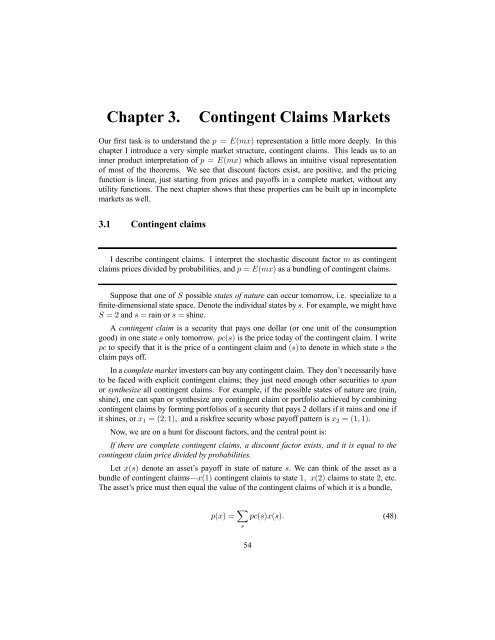Asset Pricing John H. Cochrane June 12, 2000
Asset Pricing John H. Cochrane June 12, 2000
Asset Pricing John H. Cochrane June 12, 2000
You also want an ePaper? Increase the reach of your titles
YUMPU automatically turns print PDFs into web optimized ePapers that Google loves.
Chapter 3. Contingent Claims Markets<br />
Our firsttaskistounderstandthep = E(mx) representation a little more deeply. In this<br />
chapter I introduce a very simple market structure, contingent claims. This leads us to an<br />
inner product interpretation of p = E(mx) which allows an intuitive visual representation<br />
of most of the theorems. We see that discount factors exist, are positive, and the pricing<br />
function is linear, just starting from prices and payoffs in a complete market, without any<br />
utility functions. The next chapter shows that these properties can be built up in incomplete<br />
markets as well.<br />
3.1 Contingent claims<br />
I describe contingent claims. I interpret the stochastic discount factor m as contingent<br />
claims prices divided by probabilities, and p = E(mx) as a bundling of contingent claims.<br />
Suppose that one of S possible states of nature can occur tomorrow, i.e. specialize to a<br />
finite-dimensional state space. Denote the individual states by s. For example, we might have<br />
S =2and s = rain or s = shine.<br />
A contingent claim is a security that pays one dollar (or one unit of the consumption<br />
good) in one state s only tomorrow. pc(s) is the price today of the contingent claim. I write<br />
pc to specify that it is the price of a contingent claim and (s) to denote in which state s the<br />
claim pays off.<br />
In a complete market investors can buy any contingent claim. They don’t necessarily have<br />
to be faced with explicit contingent claims; they just need enough other securities to span<br />
or synthesize all contingent claims. For example, if the possible states of nature are (rain,<br />
shine), one can span or synthesize any contingent claim or portfolio achieved by combining<br />
contingent claims by forming portfolios of a security that pays 2 dollars if it rains and one if<br />
it shines, or x1 =(2, 1), and a riskfree security whose payoff pattern is x2 =(1, 1).<br />
Now, we are on a hunt for discount factors, and the central point is:<br />
If there are complete contingent claims, a discount factor exists, and it is equal to the<br />
contingent claim price divided by probabilities.<br />
Let x(s) denote an asset’s payoff in state of nature s. We can think of the asset as a<br />
bundle of contingent claims—x(1) contingent claims to state 1, x(2) claims to state 2, etc.<br />
The asset’s price must then equal the value of the contingent claims of which it is a bundle,<br />
p(x) = X<br />
pc(s)x(s). (48)<br />
s<br />
54
















